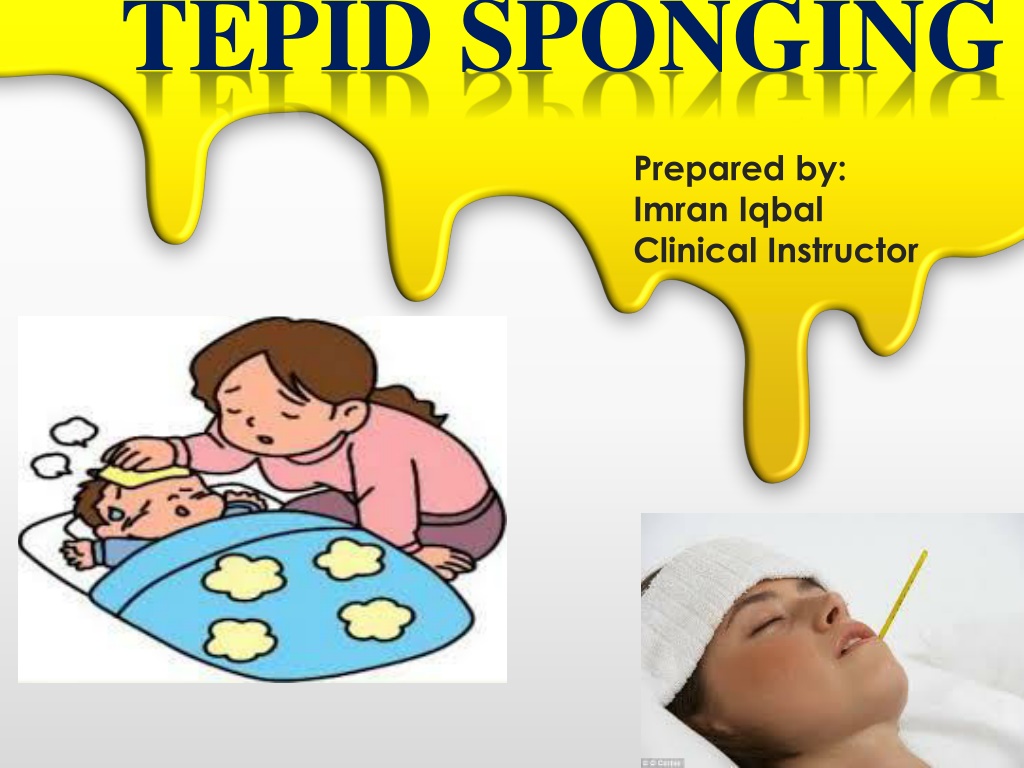Tepid Sponging Procedure in Patient Care
Tepid sponging is a technique used to reduce body temperature in patients with fever. This procedure involves applying lukewarm water to the skin surface to promote heat dispersal. Key steps include preparing the patient, collecting equipment, sponging with tepid water, and monitoring the patient's temperature. Indications, equipment needed, detailed procedure steps, and post-sponging care are outlined in this comprehensive guide.
Download Presentation

Please find below an Image/Link to download the presentation.
The content on the website is provided AS IS for your information and personal use only. It may not be sold, licensed, or shared on other websites without obtaining consent from the author. Download presentation by click this link. If you encounter any issues during the download, it is possible that the publisher has removed the file from their server.
E N D
Presentation Transcript
TEPID SPONGING Prepared by: Imran Iqbal Clinical Instructor
OBJECTIVES By the end of this section you should know to: Prepare the patient for the procedure; Collect and prepare the equipment; Carry out tepid sponging.
INDICATIONS Tepid sponging is the application of water to the patient s skin surface to promote dispersal of body heat when the body temperature is 39.5 C and over. The procedure is based on the principles of evaporation and conduction. A patient may be pyrexial when there is: Invasion by pathogenic micro organisms; Disease of the nervous system; Metabolic disorder; Malignant/neo-plastic disease.
EQUIPMENTS Basin of tepid water (29 C 32 C) Bed linen Hospital towels Disposable face cloth Gown Trolley Bed linen trolley Receptacle for soiled disposables
PROCEDURE Perform hand hygiene; Collect and prepare the equipment; Ensure patient understands and consents to procedure; Ensure the patient s privacy; Measure, record and document patient s temperature; Sponge the patient s body using tepid water;
PROCEDURE Do not dry patient leave water to evaporate; Perform hand hygiene; Change bed linen and patient s gown; Administer 1 g of paracetamol, following Administration of Medicines procedure; Measure and record patient s temperature twenty minutes after the tepid sponge; Document the procedure, monitor for after-effects and report abnormal findings immediately.
REFERENCES 1.6 Febrile Response Management cont. REFERENCES: 1. Barth, I. H. and Musgrave, C. F. (1994) How to treat the febrile cancer patient. Contemporary Oncology 4(4): 59-60. 2. Connell, F. (1997) The causes and treatment of fever: a literature review. Nursing Standard 12(11): 40-43. 3. Edwards, I. L. (1998) Update: High temperature. Professional Nurse 13(8): 521-523, 525. 4. Grossman, D., Keen, M. F., Singer, M., and Asher, M. (1995) Current nursing practices in fever management. MEDSURG Nursing 4(3): 193-198. 5. Henker, R., Rogers, S., Kramer, D. J., Kelso, L., Kerr, M., and Sereika, S. (2001) Comparison of fever treatments in the critically ill: a pilot study. American Journal of Critical Care 10(4): 276-280. 6. Holtzclaw, B. J. (1992) The febrile response in critical care: state of the science. Heart & Lung: Journal of Critical Care 21(5): 482-501. 7. Miller, C. (1993) Fever: mechanisms, controversy and research based interventions. CACCN 4(4): 30-33. 8. Sund-Levander, M., Wahren, L., and Hamrin, E. (1998) Nursing care in fever: assessment and implementation. Vard i Norden Nursing Science & Research in the Nordic Countries, 18(2): 22























